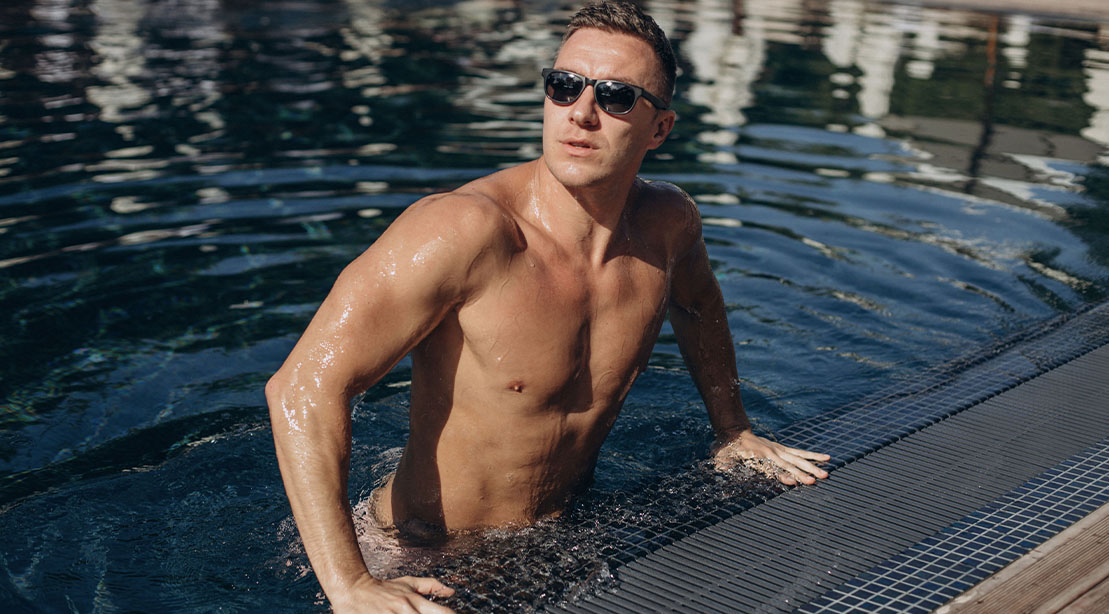28-Days-to-Lean Meal Plan
With the right plan and the right discipline, you can get seriously shredded in just 28 days.
Read article
Whether you’re freestyle swimming with your friends or treading lightly in the beach waves, time in the water calls for serious built-in resistance. From your arms to your core, the warm-weather activity can help you build lung power, muscular strength, and endurance all while lessening your chances of exercise injury.
However, before you make swimming your go-to summer workout, learning the basic swimming strokes and safety rules that come with the sport is important. Here, Fayette Mong, a swim instructor with a focus on water safety, shows you how to condition your body from head to toe as you swim your way to a stronger self.

Putting safety first is key when it comes to swimming. Mong shares her top safety tips so you can get the most out of your water workout.
“No workout, caloric deficit, muscular challenge, or endurance build is worth drowning,” says Mong, who explains drowning occurs in quick, silent increments of loss of breath. “Even the most skilled swimmers have muscle cramps, muscle spasms, appendix ruptures, and slips and falls.” Swim with a buddy, at a minimum. There should be a lifeguard on duty, but if not, Mong recommends CPR education. “Open and dark water is exponentially more dangerous than a controlled environment.”
If one is adamant about swimming alone, Mong encourages you not to eat within two hours of swimming. Also, “Bring a loud whistle attached to your suit, in-tact gear is important (goggles, cap, etc.).”
Float first. “Always remember that back floating, rather than treading, is the safest way to rest and gather one’s wits and bearings.”
If one swims in dark and open water for recreation or leisurely exercise, Mong recommends wearing a Coast Guard-approved life jacket that is specifically rated for one’s weight (all Coast-approved life jackets state their certification and ratings in bold letters on the life jacket).
Swim lessons save lives. “If learn-to-swim lessons are too much of an investment, every person near the water should at least know how to back float independently.” You’re never too old to take lessons.
Now that you have your gear and safety rules in check, it’s time to take your workout to the water.

If you’re looking to make swimming a part of your workout routine, having the right gear is key. Mong outlines swim essentials that will help you get the best out of your swim sessions.
1. A snug-fitting swimsuit: Extra material on your swimsuit creates drag and distractions. Training suits should fit more snugly than recreational and leisure swimsuits. While suit style can be based on preference, larger-chested individuals may want to err on the side of a onesie, as they lend the best support. For those wearing only trunks, jammers are advisable to decrease chafing and streamline fabric.
2. Goggles: Goggles that fit snugly around the eyes (and only the eyes), with two adjustable straps that do not roll or slide up and down the head.
3. Swim cap: A silicone swim cap that fits very tightly around the entire head and hair (hair should be pulled back and tucked all the way into the cap), so that the goggles adhere to the cap without slipping off.
Tip: (For those sensitive to constriction around the scalp, nylon caps are useful, but do not retain body heat as well as silicone.) If you run cold, double cap with silicone caps.
4. Not necessary, but great extras: A kickboard, underwater earbuds, waterproof watch for tracking workouts.
Tip: Mong recommends wearing bright-colored suits to avoid blending in with water. If you happen to need rescuing, this will make you more visible.
Even basic swim strokes can provide an intense workout in the right sequence. As you learn these swim strokes, you’ll be increasing your safety levels while working on your strength endurance.
We will go over the following swimming strokes: Float, Flutter, Freestyle, Backstroke, and Breaststroke.
This important swim move can not only save your life but is a great “rest” in between swim sets. (Ear plugs come in handy for this one). Practice with a buddy to up your safety level.
Over time, you will be able to decrease kicks into a static float.
Tip: Mouth breathing can help prevent water from entering the nose. Some prefer to inhale as the arm passes the ear and exhale when the opposite arm passes the opposite ear.
The stroke is said to be the most popular of the strokes. If you can remember to pull, breathe, kick, glide, you’ll be all set.

Now that you’ve learned important swim strokes and know how to stay safe in the water, it’s time for a calorie-burning workout you can do all summer long.
Before Your Workout: If it’s been a while since you’ve been in the water, Mong says it’s important to practice the sensation of buoyancy and water resistance before tackling a full workout. “Go for a recreational swim with a buddy to water-walk, and practice efficient arm, leg, and foot movements. Rekindle your trust in floating, and calm breathing. Help each other get into proper float and stroke formations,” she says.
Warm up with a 50-yard backstroke on the back. (1 length of a standard pool is 25 yards.)
Workout: perform 300 free, 50 breast, 250 back, 50 breast, 250 free.
Warm down with 50 yards kicking on back. Take little to no breaks, or only occasional 30-second breaks. It’s better to slow the swim, rather than break.
Warm up with 50 breaststrokes and 50 free.
Workout: All sprints: 100 free swim, rest 20 seconds. 100 free swim, rest 20 seconds, 100 free, rest 30 seconds, 100 back, rest 30 seconds, 100 free.
Warm down with 50 kicking on the back and 50 breaststrokes.